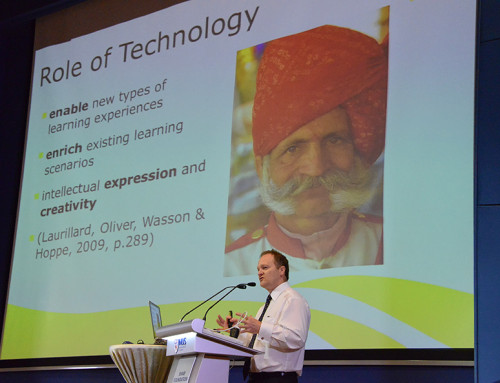 I was fortunate to be invited as a visiting scholar with the Centre for Development of Teaching and Learning (CDTL) at the National University of Singapore (NUS) from the 29th September until the 12th October, 2013. NUS is consistently ranked as one of the top research universities in the world and I was delighted to engage in dialogue at NUS about learning, teaching and research. NUS has an enviable IT infrastructure with ubiquitous wi-fi across the campus including the campus buses allowing staff and students to connect 24/7.
I was fortunate to be invited as a visiting scholar with the Centre for Development of Teaching and Learning (CDTL) at the National University of Singapore (NUS) from the 29th September until the 12th October, 2013. NUS is consistently ranked as one of the top research universities in the world and I was delighted to engage in dialogue at NUS about learning, teaching and research. NUS has an enviable IT infrastructure with ubiquitous wi-fi across the campus including the campus buses allowing staff and students to connect 24/7. During the visit I focussed on providing advice to NUS staff on blended learning, digital literacies, personalised learning, learning-oriented assessment and learning spaces through consultations with staff. The consultations were initiated by the staff and mainly focussed on providing learning design advice on learning and teaching approaches and assessment. I participated in around 30 consultations with over 100 staff including the Provost of NUS. I also completed two keynote presentations and a workshop which are outlined below. The visit was part of a unique academic exchange called the Educator-in-Residence Programme (EiRP).
The EiRP was conceptualised to provide a platform for Distinguished Educators in Universities to come to NUS to share their expertise with NUS colleagues and students through a range of activities such as seminars/lectures, informal consultations, social interactions and possible future research collaborations. The objectives of the programme comprised:
- To facilitate the exchange of ideas, expertise and perspectives in education, policies, pedagogy and innovations between the EiRP visitor, NUS faculty members, Fellows of the NUS Teaching Academy and NUS Administration;
- To engage the NUS teaching community in teaching and learning issues so as to promote best practices in teaching and learning;
- To provide opportunities for possible institutional link-ups for teaching and/or research collaborations, study trips and informal exchanges;
- To cultivate an external network of partners to broaden our expertise in education.
During the visit I was engaged in a range of activities that encompassed:
- A Public Lecture entitled the “Ruth Wong Memorial Lecture on Education”
- Keynote presentation at the Technology-enhanced Learning Symposium in NUS
- A workshop focussed on learning spaces
- Discussions with the CDTL team, the NUS Teaching Academy, and members of the Provost’s Office
- Informal discussions with small groups of colleagues from specific faculties/departments.
Ruth Wong Memorial Lecture on Education
 Dr Ruth Wong Hie King was well known for her commitment to education and was a respected figure in Singapore’s education history. She was a visionary educator and many of her ideas in the 1970’s have now become a reality. I had the pleasure of having lunch with the Wong family and was taken by the passion and enthusiasm of the family for education. The Memorial Lecture Series is undertaken each year and is made possible by the generous support of the Wong family and is hosted by the National University of Singapore. I had the honour and privilege of delivering a lecture on Digital Literacies as part of the Distinguished Lecture Series in Education. The abstract for the session is outlined below as well as links to the presentation slides.
Dr Ruth Wong Hie King was well known for her commitment to education and was a respected figure in Singapore’s education history. She was a visionary educator and many of her ideas in the 1970’s have now become a reality. I had the pleasure of having lunch with the Wong family and was taken by the passion and enthusiasm of the family for education. The Memorial Lecture Series is undertaken each year and is made possible by the generous support of the Wong family and is hosted by the National University of Singapore. I had the honour and privilege of delivering a lecture on Digital Literacies as part of the Distinguished Lecture Series in Education. The abstract for the session is outlined below as well as links to the presentation slides.
Digital Literacies: Knowledge, Skills and Attitudes for a Digital Age
Digital literacies are fast becoming a necessity for life – they encompass the knowledge, skills and attitudes that will enable individuals to learn, work, live, play and interact more effectively in the digital age. An increasingly wide range of information, media, business services, and entertainment require digital literacies. These new forms of literacies may involve technical, cognitive and social-emotional dimensions (Ng, 2012) as well as mindfulness and the critical appraisal of ubiquitous internet information (Rheingold, 2012). The need for digital literacies has implications for both K-12 and higher education as teachers and students at all levels will require new literacies to teach and learn. Being digitally literate involves students and teachers developing their digital identities in an age where our online presence can be as important as our physical presence in social and work environments. Digital identity focuses on how we represent or portray ourselves online. It includes the etiquette and ethics of communicating and doing business online, leading to safer and more engaged digital citizenship. This presentation will focus on the importance of digital literacy skills for both K-12 and higher education.
Personalising Learning for New Generation Students
This presentation focused on how new generation tertiary education students interact in a digital age. It discussed how
they adapt and customise their learning and personalise their interactions to suit their needs. It argued that students need to acquire a range of literacies to successfully personalise their learning and social environments. New generation tertiary education students are characterised by having a rapport or relationship with technology and they have an inherent need to express themselves through multiple avenues which utilise user-generated content. User-generated content includes artefacts created by the student that are uploaded to the internet for sharing with other people. Knowledge acquisition now focuses on networks and ecologies, and knowledge now requires literacies in networking (Siemens, 2006). In addition, our learning is increasingly mobile as we move through a wider range of spaces. We now expect to be able to work, learn, and study whenever and wherever we want (Johnson, et al, 2012).
Owning the place of learning: Principles for designing personal learning spaces for learners and teachers
Personal learning spaces constitute the formal and informal spaces and technologies customised by the learner or teacher. They are spaces that are owned by the learner or teacher. However, insufficient attention has been given to providing assistance to learners and teachers to design their own personal learning spaces. This workshop provides a framework for personal learning spaces that includes: distributed learning spaces, seamless learning and principles of learning space design that assist learners and teachers to design their own personal learning spaces. Distributed learning spaces include physical, blended, virtual mobile, personal, outdoor, academic and professional practice spaces (Keppell & Riddle, 2012). Seamless learning occurs when a person experiences a continuity of learning across a combination of locations, times, technologies or social settings (Sharples, et al, 2012). Seven principles of learning space design include: comfort, aesthetics, flow, equity, blending, affordances and repurposing (Souter, Riddle & Keppell, 2010). By taking account of distributed learning spaces, seamless learning and principles of learning space design both learners and teachers will be empowered to construct their own personal learning spaces.









Leave A Comment